Pamela Silver at the First Qingdao International Art Biennale September 22 to November 22, 2014.

| Creative Arts Educ Ther (2022) 8(2):237–251. | DOI: 10.15212/CAET/2022/8/23 |
Artist spotlight: Interview with Pamela Silver: A Lifetime of Painting in Colors
艺术家聚焦: 采访帕梅拉·西尔维 (Pamela Silver):一生以色彩作画
Lesley University, USA
September 1, 2022
Pamela Silver is a South African-born artist who lived as a child in Rhodesia (now Zimbabwe). She completed her BA at the University of Cape Town, SA, and Goldsmith College in the UK and continued her studies in the arts in the USA and Israel. She immigrated to Israel in 1973, where she currently lives. She considers herself to be an intuitive artist creating artwork in watercolors, prints, and oils. Pamela studied at Art Students’ League, New York, from 1982 to 1983, and is a member of the Israel Society of Painters and Sculptors since 1985. She has exhibited in over 90 exhibitions worldwide, including 25 solo exhibitions. Her art has been exhibited in museums and galleries worldwide in Europe, China, Japan, Russia, the USA, the UK, Africa, and Israel. Her 26 solo exhibitions include the Irma Stern Museum in Cape Town in 2018, the Ben Uri Gallery and Museum in London, the National Gallery of Zimbabwe in Harare and Bulawayo, Spier in Stellenbosch, Museum Aqua in Lisbon, the Leighton House Museum in London, the Zaritsky Artists House in Tel Aviv, and the Artists House in Jerusalem. The highlights of group exhibitions include the Osaka Triennial Print in Japan (1998), Second Beijing International Art Biennale in Beijing (2005), Olympic Fine Art Exhibition in Beijing (2008), III and IV National Drawing Biennale in Israel (2007 and 2010), the Royal Academy of Arts Summer Exhibition in London (2015), the Original Print Show curated by Norma Ackroyd, CBE, RA, in the Zillah Bell Gallery in Thirsk, UK (2015), and the Masters Etching of the Royal Society of Painters–Printmakers in London (2016).
Pamela Silver’s art is in the collection of the Israel Museum in Jerusalem, the Tel Aviv Museum in Tel Aviv, the Victoria and Albert Museum in London, and the National Museum of Women in the Arts in Washington, DC.
Pamela Silver at the First Qingdao International Art Biennale September 22 to November 22, 2014.

Vivien Marcow Speiser: Your work is suffused with color—what do you attribute this to?
Pamela Silver: The garden of my childhood was covered in flowers and tended by gardeners from Malawi. I remember the colors of the trees, the earth, and the jacaranda trees, and the sounds that the flowers of the jacarandas made especially after the rains had fallen, as my feet squished them in walking across the lawns. The colors of nature growing up in Rhodesia, now Zimbabwe, gave me the pathways and the patterns for my artwork for the rest of my life. I learned about color from the natural world around me. My mother taught me about fabrics in the ways that she decorated the house, and my father was a businessman who specialized in imported fabrics from around the world. I started drawing and painting in my early childhood and remember vividly sitting under the trees with paints in the garden of my house and beginning to draw and paint what I was seeing. As a child, I was very connected to the beauty of the natural environment around me and saw the trees as living beings to whom I felt a deep connection. Trees are real, like people, and they speak to me.
When I was a child
The garden was something human
The Jacarandas were like big good friends
—From my book A Journey Home to Zimbabwe
As a child I remember the smell of the rain in the afternoon as it came down.
First, I would see the heavy rain clouds. The air would be hot and heavy and the earth crying out for water. If the jacaranda trees were full of flowers, the rain would bring them down on to the hot red earth, and it was my greatest joy to jump barefoot on the jacaranda flowers and hear the music they made and smell the amazing smell that came out of the flowers.
“A Beautiful Afternoon in the Garden” 2017 watercolor 38×28. Inspired by my garden in Jerusalem and the garden I had as a child in Bulawayo.

Vivien Marcow Speiser: What was your schooling experience like as a child, and how did this affect your development as an artist?
Pamela Silver: I went to a convent school close to my house, and growing up as a Jewish child in a Christian school, I felt the potential pulls of both religions. In school, I was required to attend church and to worship on my knees, but I resolved this issue by doing this on only one knee. My Jewish grandmother who came from Vilnius in Lithuania was also an ardent Zionist, and I attribute to her my later immigration to Israel due to her influence. I also attended Habonim, a left-leaning Zionist Youth Movement, which was an important influence on my development. At the age of 10, I won my first prize as an artist in a national painting competition.
“Maybe I Saw Myself as Black, Maybe as Christian” 70×84 cm oil on linen 2008 from 9 years in a day convent.
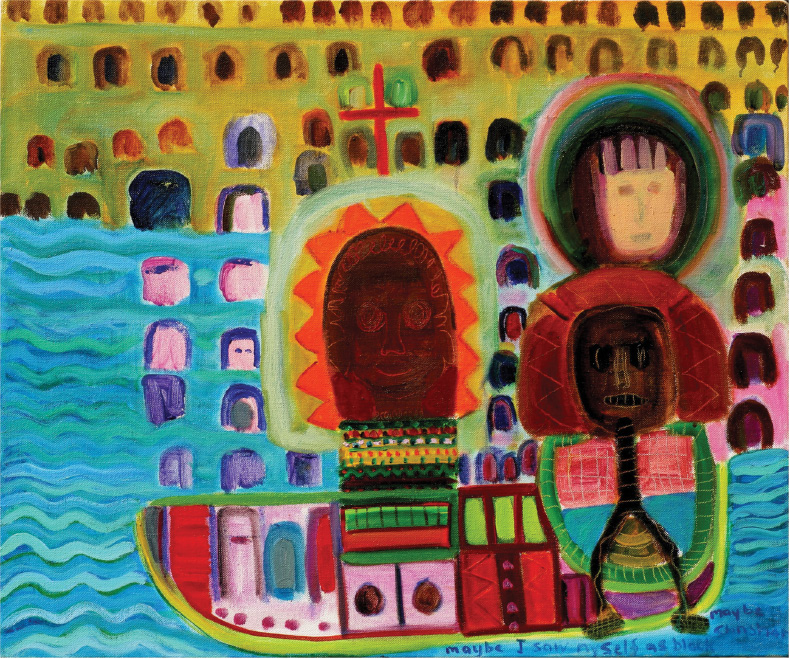
Vivien Marcow Speiser: Were there other seminal influences on your work during your childhood?
Pamela Silver: The Bushmen paintings in the caves in the Matobo Hills where I spent my weekends. I saw the intuitive documentation of their lives. The energy and simplistic movement of man and animal. This is a painting drawing upon those themes.
“The Dance” 2013 watercolor 28×38.
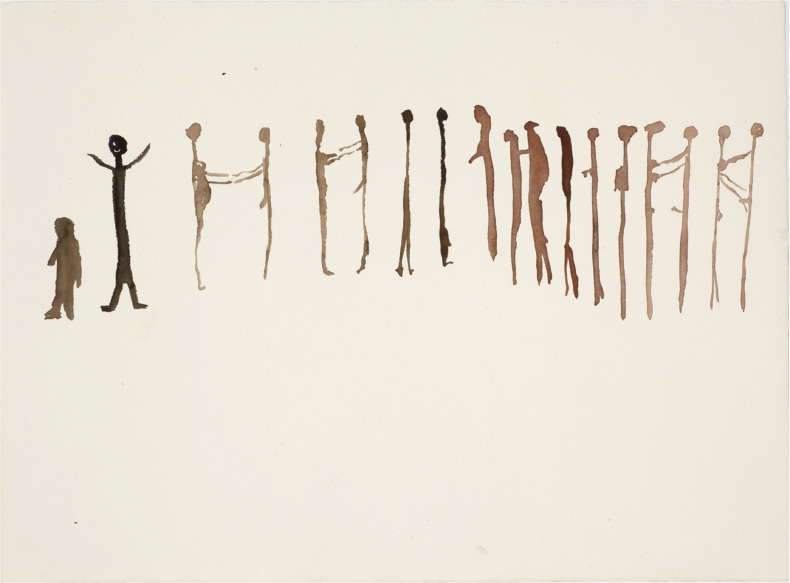
These paintings, their caves, the hillsides, and grasslands, were filled with flying buck, and bird songs were my museums, art galleries, and concert halls.
Another important influence on my artistic development as a child was the artist Marshall Baron (1934–1977), who was a Rhodesian painter whose work is exhibited in the National Gallery of Zimbabwe. He had a studio in the Matobo Hills where I would visit, and he was a significant formative influence in my artistic development. I saw the rocks in the Matobo Hills as spiritual beings located in a spiritual place, and the strong visceral impression they made on me appears in my paintings related to the Matobos.
Pamela Silver writes about Marshall
“I knew Marshall from when I was very young as we lived on the same road, our parents were good friends and I was a friend of his sister Beverly.
I was always fascinated by Marshall—his love of music and the paintings he created in the room on the left as one climbed the stairs in the Baron’s beautiful home. I once spent three weeks with the Baron’s when my parents went overseas. I was seven years old, and a large part of the time I was there, I spent watching Marshall paint and looking at his art, and listening to the music he played on gramophone. I loved Marshall and his paintings—they inspired me and remain a very important part of my memory of art.”
—http://www.marshallbaron.com/tributes/people/pamela-silver/
A painting about Zimbabwe with all its colors in autumn in the Matobos Hills, my favorite place, Oil on canvas 135×210.
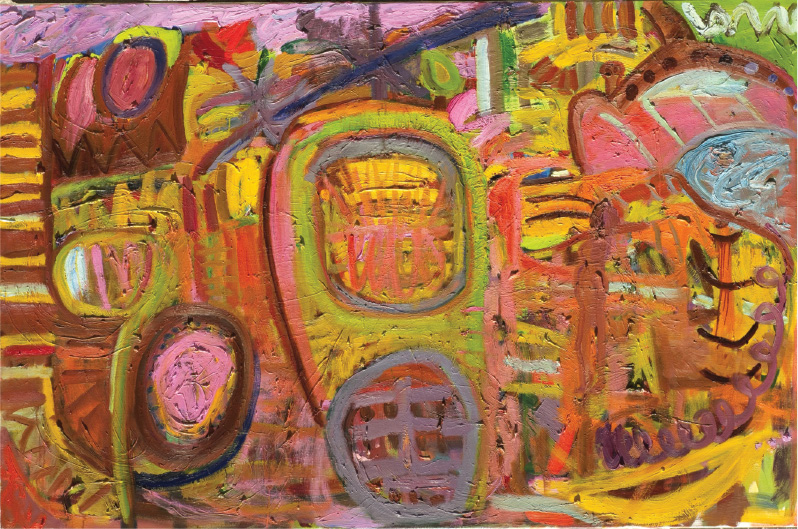
Vivien Marcow Speiser: After starting to paint early in your childhood, did this trend continue?
Pamela Silver: I stopped painting from the ages of 12–21. I went on to University in Cape Town and completed my BA degree in history and then studied for a postgraduate teaching certificate at Goldsmith College in London. There I started to paint again in my education classes and re-discovered the keys to opening my creativity. In 1973, I immigrated to Israel and found myself living in a country where one could be free to be anything one wanted to be. Nothing had to be perfect anymore in the ways of being I had grown up with in Rhodesia, South Africa, and later the UK. I returned to painting and studied with several teachers, starting with the German painter Yona Mach and immigrant Russian painter Aharon April and eventually landed up studying for a year in New York, where I studied abstract expressionist painting in the Art Student League with Leo Manso and Richard Pousette-Dart for what I consider one of the best years of my life. After we returned to Israel, we built a new house, and I created the garden that continues to sustain my work and feed and nourish my creative process.
Vivien Marcow Speiser: What was the impact of creating this garden on your creative work and process?
Pamela Silver writes: “I am an intuitive artist, painting my deep inner world. My childhood in Africa, the natural beauty of wide open spaces and the trees are a rich source of knowledge in my art. I have created a magical garden filled with trees, flowers and birds in our home in Motza Illit on the outskirts of Jerusalem and here I paint. I try to create a feeling of peace and harmony within my work, and to rouse awareness to the beauty of nature and the healing power of trees, flowers, the sea and the sky.”
—https://www.art.org.il/?jerusalem-artists=silver-pamela&lang=en
From this garden, Pamela creates, and her work begins to shift to more abstract renditions.
She writes “It’s a beautiful Spring day in Jerusalem, the birds are singing, the flowers and garden are shining in their colors, the blossoms are out on the apple tree and all the trees are sending out their new leaves with hope and joy for a happy, safe and healthy time. I wish all who celebrate Passover and Easter a joyous carefree time.
What is creativity, what is color, what is the stream of consciousness?
It is nothing but the need to express the fire of thought, feeling and passion.
I like most to paint where it is very beautiful, where the scenery is huge and grand and there are no buildings or modern intrusions. I like to paint and eat and sleep again.
I like to look silently at the beauty of the sea, and the mountains. To see the waves knocking against each other and the rocks. I love to feel the spray of the sea, the smell of the fish and the openness, so that I am close to g d and nature.”
“Bamberg” 2003, 28×18 cm.
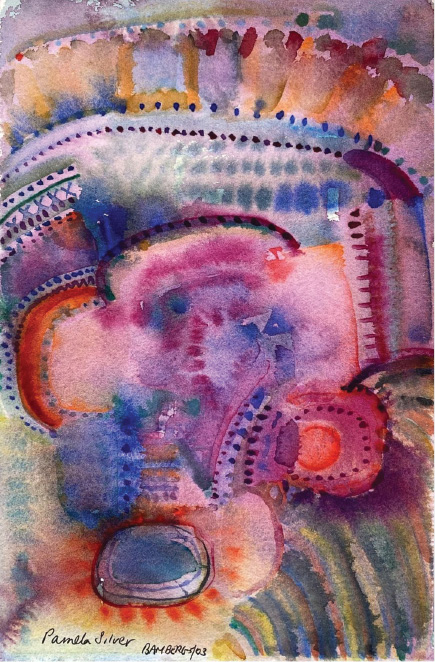
Vivien Marcow Speiser: How does your work shift after this?
Pamela Silver: My work begins to expand outwards, and I received many invitations to participate in international shows, and I begin to travel the world as an artistic ambassador.
She writes about her exhibit at the Irma Stern Museum in Cape Town: “My travels and the countries I have visited have inspired me too.” Her paintings, “always start in nature, but transcend to different worlds, different levels of consciousness, memories, feelings, hopes, dreams, moments in time that keep returning.”
—https://mapmyway.co.za/colour-light-uct-irma-stern-museum/
Vivien Marcow Speiser: What happened next in your creative process?
Pamela Silver: A breakthrough painting, “Circles in the Sand,” was painted during the Intifada in 2002, during a very traumatic time in Israel where I found a way out by painting memories of beautiful times by the sea in Cape Town as a child. This painting later took me to the Biennale Beijing 2005 and the Olympic Fine Art Exhibition in Beijing in 2008, and then forming an international group of artists from all the countries, we had met there.
“Circles in the Sand” 2002 watercolor 50×50 cm.
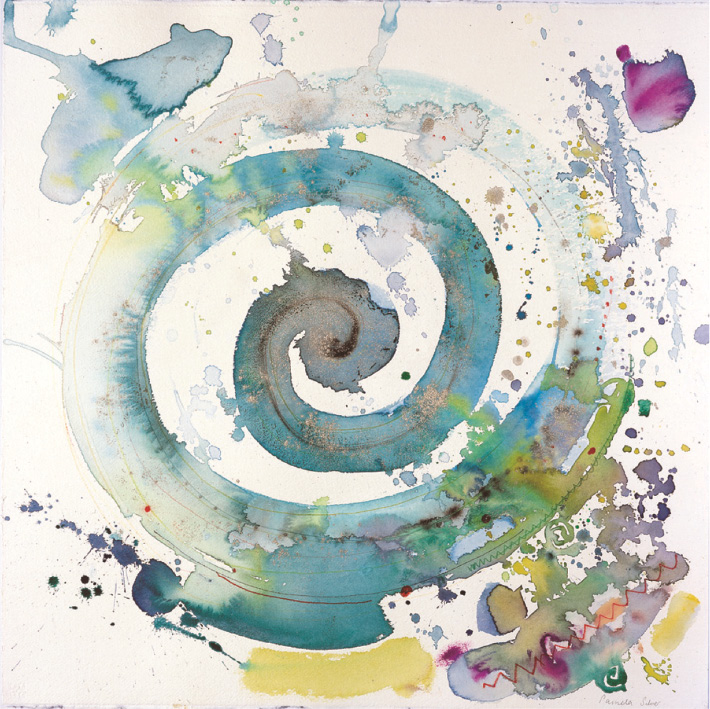
Vivien Marcow Speiser: I have noticed a certain progressive resonance in your work to an affinity with Asia and the Far Eastern countries. Can you talk a little about this resonance?
Pamela Silver: I have participated in many international competitions around the world. I think that some of that resonance has to do with a certain element of joy, friendship, life, and my use of color that appealed to the curators of these international exhibitions. Some of the exhibitions I have participated in include the Osaka Triennial Print, Japan (1998), the Second Beijing International Art Biennale, Beijing (2005), and the Olympic Fine Art Exhibition, Beijing, 2008.
I also participated in the First Qingdao International Art Biennale in 2014 and the Hangzhou Qianjiang International Art Museum in November 2018, where I received an award.
Pamela Silver receives an award at the Hangzhou Qianjiang International Art Museum in November 2018,
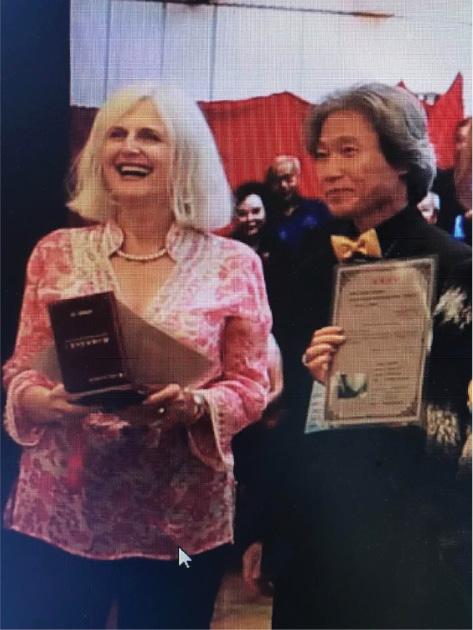
I attribute this resonance to the simplicity of my artistic expressions, the concentration of energy and energetic movement, and the minimalistic strong energy within the paintings. I attribute this energy in part to being a strong butterfly swimmer in my childhood, where, in 1964, I was chosen to represent Rhodesia in the Olympics. While I did not at that time go on to participate in the Olympic competitions, I feel that, in many ways, I did master the discipline and that it translated into my painting style. I am good at concentrating energy within myself, protecting that energy, and then letting it all out in my painting, working in concentrated time.
I, in turn, resonate with the Eastern influences of honor and have enjoyed visiting countries where artists are valued as national treasures and are treated with gentleness, appreciation, softness, and serenity. An example of this follows
“Light at the End of the Corridor” 2021 watercolor 38×57.
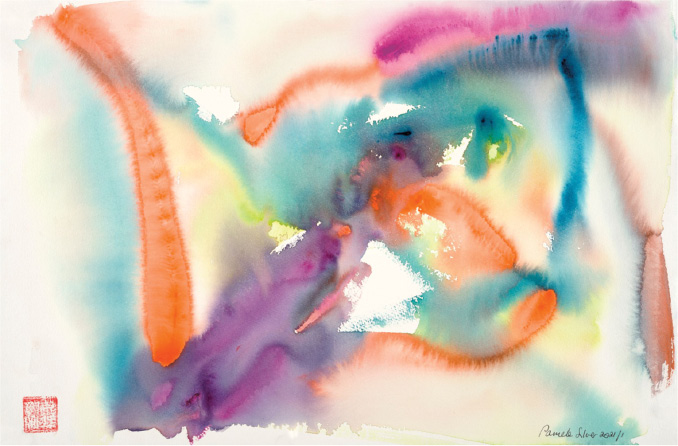
Vivien Marcow Speiser: Could you talk a little about your paintings that have been a source of personal healing for you?
Pamela Silver: I have a series of painting called the “The Rise and Fall of an Anxiety Attack,” which have been instrumental in my own healing process. These were printed when my mother was dying and in the aftermath of the Intifada. These prints helped me cope with the feelings of anxiety that would mount and then subside over and over, and during one of these anxiety attacks I created this series of monotypes. It helped me understand that strong feelings could arise and then move through me and that I could get over it.
“The never-ending feeling” 1999, monotype 40×40.

When my mother died in London, I spent a great deal of time with her just being in the space of this transition. After her death, we brought her body to Israel for burial, and I created a series about the human condition, which included 40 monotypes I produced after my mother’s death. I called the series “The Stages between Life and Death,” inspired by watching my mother in the last days of her life traveling from life to death. The piece below is titled “Going to Heaven.”
“Going to Heaven” 2001, monotype 22×30.
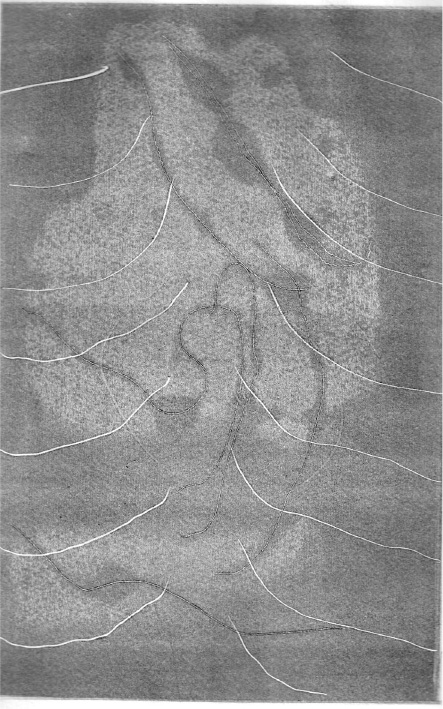
“Another form of healing for me was a series of mandalas, including “Myself,” which was a part of my process of healing from my grief after my mother’s death.
“Myself” 2003, watercolor on Japanese handmade paper 50×50.
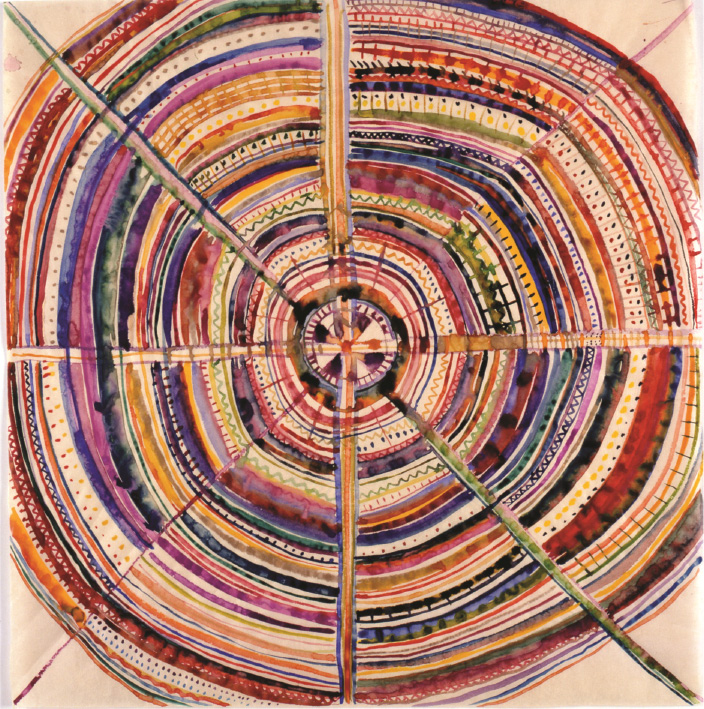
I continued with this process by painting hundreds of mandalas in all sizes and exhibited them at the Museu Da Agua Lisbon, including the piece below “Sunrise over Jerusalem.”
“Sunrise over Jerusalem” 2003, watercolor on handmade paper 60×60.
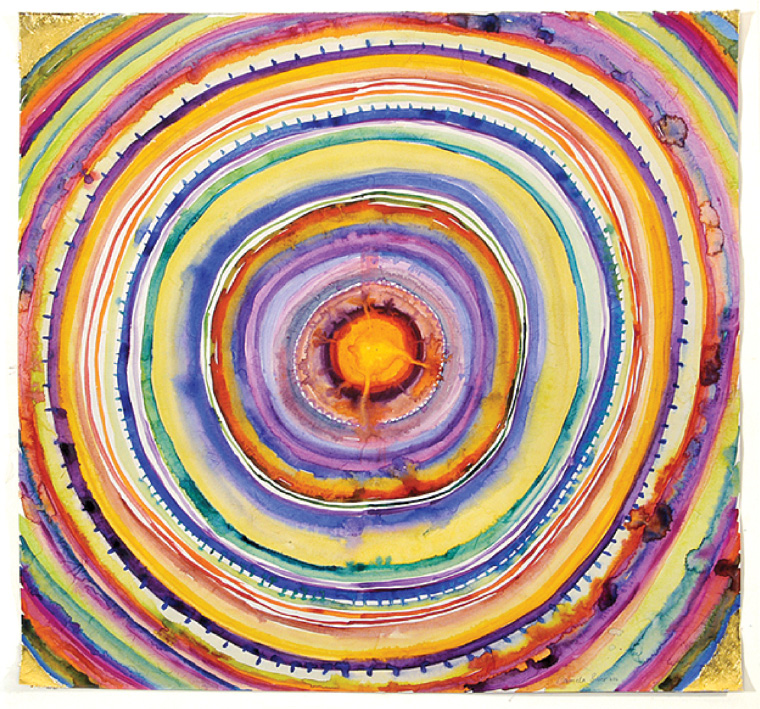
Vivien Marcow Speiser: What are you painting now?
Pamela Silver: I am painting the flowers in my garden. I have tall zinnias and marigolds, and I am also working on a diary where I am recording some of my feelings, including the happiness of being alive post-COVID. I feel the strength of getting through and over it. I am playing with color, and it is pure joy.
“The Human Condition of Resilience and Healing after Corona” 2022, Watercolor 58×38.
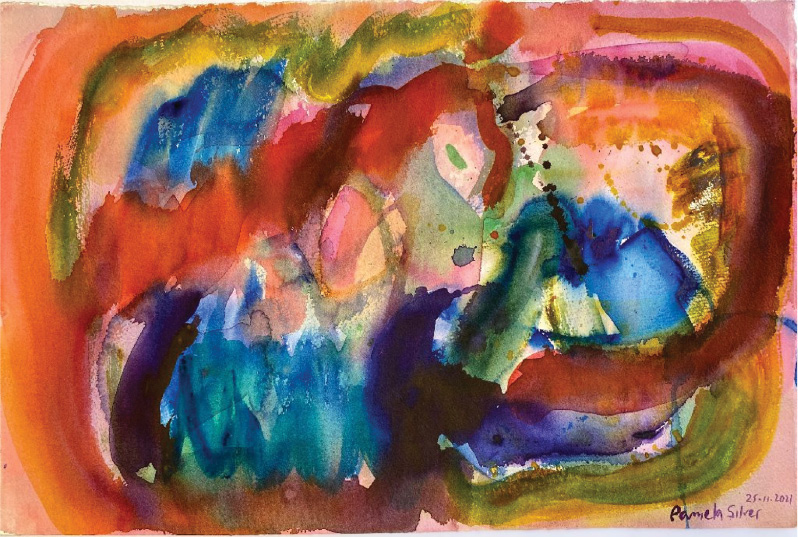
About the Author
Vivien Marcow Speiser, PhD, LMHC, NCC, BC-DMT, REAT, is a Professor Emerita and Co-Director of the Institute of Arts and Health at Lesley University, in Cambridge, Massachusetts. She has directed and taught in programs across the United States and internationally and has used the arts as a way of learning, communicating across borders and across cultures. She believes in the power of the arts to create the conditions for personal and social change. She consults with educational and other organizations on program development and implementation regionally, nationally and internationally. Her work across the globe has garnered recognition and made her an international leader in dance and expressive therapies. She received the 2014 Distinguished Fellows Award from the Global Alliance for Arts and Health, a 2015 Honorary Fellow Lifetime Achievement award from the Israeli Expressive and Creative Arts Therapy Association and, more recently, the 2019 Lifetime Achievement award in Applied Arts and Health as well as a Fulbright Senior Scholar awards in 2020 and 2023.